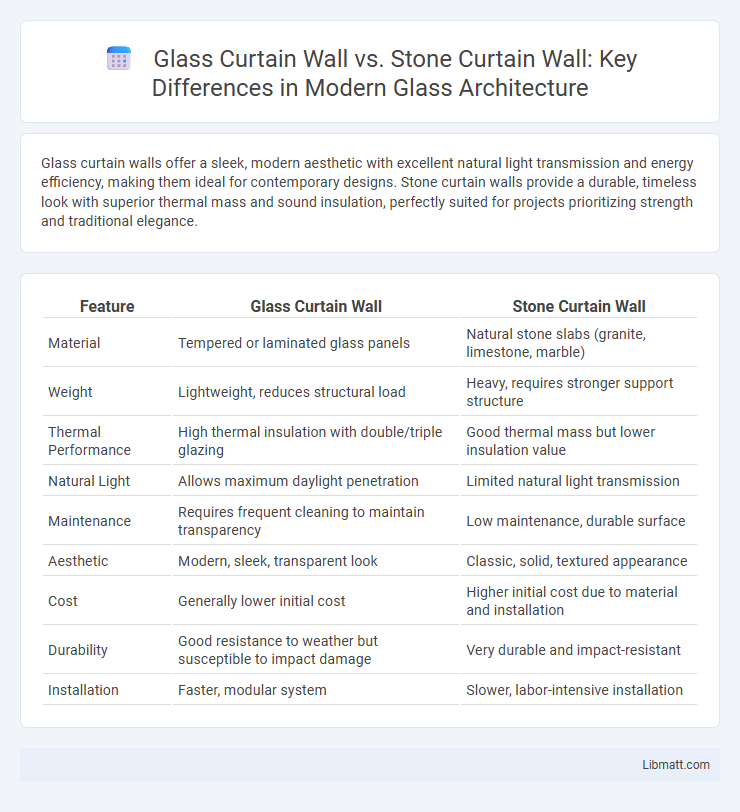Glass curtain walls offer a sleek, modern aesthetic with excellent natural light transmission and energy efficiency, making them ideal for contemporary designs. Stone curtain walls provide a durable, timeless look with superior thermal mass and sound insulation, perfectly suited for projects prioritizing strength and traditional elegance.
Table of Comparison
| Feature | Glass Curtain Wall | Stone Curtain Wall |
|---|---|---|
| Material | Tempered or laminated glass panels | Natural stone slabs (granite, limestone, marble) |
| Weight | Lightweight, reduces structural load | Heavy, requires stronger support structure |
| Thermal Performance | High thermal insulation with double/triple glazing | Good thermal mass but lower insulation value |
| Natural Light | Allows maximum daylight penetration | Limited natural light transmission |
| Maintenance | Requires frequent cleaning to maintain transparency | Low maintenance, durable surface |
| Aesthetic | Modern, sleek, transparent look | Classic, solid, textured appearance |
| Cost | Generally lower initial cost | Higher initial cost due to material and installation |
| Durability | Good resistance to weather but susceptible to impact damage | Very durable and impact-resistant |
| Installation | Faster, modular system | Slower, labor-intensive installation |
Overview of Glass Curtain Wall and Stone Curtain Wall
Glass curtain walls consist of large glass panels set within aluminum or steel frames, offering transparency, natural light, and modern aesthetic appeal, commonly used in high-rise buildings. Stone curtain walls feature natural or engineered stone panels anchored to the building structure, providing durability, thermal insulation, and a traditional, solid appearance. Both systems act as non-load-bearing facades, protecting interiors from weather while enhancing architectural design.
Key Differences Between Glass and Stone Curtain Walls
Glass curtain walls offer superior natural light penetration and modern aesthetic appeal, enhancing energy efficiency through advanced glazing technologies. Stone curtain walls provide exceptional durability, thermal insulation, and a timeless appearance, often requiring less maintenance over time. Your choice depends on balancing visual transparency needs with structural robustness and long-term performance preferences.
Aesthetic Appeal and Design Flexibility
Glass curtain walls offer a sleek, modern aesthetic with high transparency, allowing natural light to flood interiors and creating a visually striking facade. Stone curtain walls provide a timeless, textured appearance with rich color variations that convey durability and sophistication. Your choice depends on whether you prioritize contemporary design flexibility and light transmission or classic elegance and material uniqueness.
Structural Performance and Durability
Glass curtain walls offer superior flexibility and lighter weight, providing excellent seismic resistance and allowing for expansive, transparent facades that reduce building load. Stone curtain walls deliver exceptional durability and long-term resistance to weathering, impact, and thermal variations due to their dense, natural material composition. Structural performance favors glass curtain walls in terms of adaptive load distribution, while stone curtain walls excel in longevity and maintenance reduction.
Energy Efficiency and Thermal Insulation
Glass curtain walls provide superior natural daylight penetration, reducing the need for artificial lighting, but typically have higher thermal conductivity, impacting energy efficiency unless equipped with advanced glazing technologies like low-emissivity coatings and insulated glass units. Stone curtain walls offer excellent thermal mass and insulation properties, maintaining stable indoor temperatures by absorbing and slowly releasing heat, thus enhancing energy efficiency in climates with significant temperature fluctuations. Both systems require careful design considerations to optimize energy performance, with glass walls benefiting from cutting-edge glazing technologies and stone walls leveraging material density for thermal regulation.
Installation Process and Construction Time
Glass curtain walls typically feature prefabricated panels that simplify the installation process, reducing on-site labor and accelerating construction timelines. Stone curtain walls demand precise craftsmanship and heavier materials, leading to longer installation periods and increased construction time. Efficient project management is crucial to balance the speed advantages of glass with the durability benefits of stone in facade design.
Maintenance Requirements and Longevity
Glass curtain walls typically require regular cleaning to remove dirt, pollutants, and water spots, as well as periodic inspection of seals and frames to prevent leaks, contributing to moderate maintenance demands. Stone curtain walls offer greater durability with minimal maintenance, often only needing occasional inspections for mortar joints and cleaning to prevent staining or moss growth, resulting in longer lifespan and reduced upkeep costs. The inherent weather resistance and robustness of stone curtain walls generally translate to superior longevity compared to glass curtain walls, which may face issues like seal failure or glass breakage over time.
Cost Comparison: Initial and Long-Term Expenses
Glass curtain walls typically have higher initial costs due to specialized materials and installation but offer energy efficiency benefits that can reduce long-term expenses. Stone curtain walls involve lower upfront costs but may lead to increased maintenance and repair expenses over time because of their susceptibility to weathering and material degradation. Evaluating project-specific factors such as building design, climate, and maintenance capacity is essential for accurate cost comparison between glass and stone curtain walls.
Environmental Impact and Sustainability
Glass curtain walls offer high energy efficiency through natural daylighting and thermal insulation, reducing the building's carbon footprint and reliance on artificial lighting and HVAC systems. Stone curtain walls provide durability and thermal mass, which can improve energy performance by stabilizing indoor temperatures and minimizing heating and cooling demands over time. Both materials can be sourced sustainably, but glass typically requires more energy-intensive production, while stone extraction impacts ecosystems, making lifecycle assessment critical for environmental impact optimization.
Choosing the Right Curtain Wall for Your Project
Glass curtain walls provide superior natural light penetration and modern aesthetic appeal, ideal for commercial buildings aiming to enhance energy efficiency with insulated glazing units. Stone curtain walls offer exceptional durability and thermal mass, making them suitable for projects prioritizing longevity and natural material appeal. Your choice depends on balancing desired transparency, maintenance requirements, climate conditions, and architectural style.
glass curtain wall vs stone curtain wall Infographic

 libmatt.com
libmatt.com